Слайд 2Lecture outline
Attachment
Parenting styles
Birth order
Types of play
Peer pressure

Слайд 3Attachment
Attachment – positive emotional bond that develops between a child and particular

individual:
Freud – A grew out of mother’s ability to satisfy a child’s oral needs;
Harlow – food alone is insufficient to bring about attachment;
John Bowlby – A is based on infants’ need for safety and security. A provides safe base for the development of independence
Mary Ainthworth – strange situation experiment, caregiver as secuire base;
Слайд 4Attachment
Securely attached children (2/3)
Avoidant children (20%)
Ambivalent children (12%)
Disorganized-Disoriented children

Слайд 5How attachment develops?
Sensitive to infant’s needs;
Aware of infants’ moods;
Provide appropriate responses;
Attachment styles

are stable from one generation to another;
When stressed infants tend to prefer mothers;
Fathers play, mothers feed and nurture.
Слайд 6When attachment develops?
Phase 1. Nonfocused orienting and signaling;
Phase 2. Focus on one

or more figure – 3 months
Phase 3. Secure base behavior – 6 months
Margaret Mahler, 1975:
Baby, 6 months: “I love you, and I don’t want to be messing around with anyone else”
Baby, 18-24 months, aware of own vulnerability: “Hey, wait a minute! I am too little to be away from you for too long: I can’t take care for myself. I need you!”
Слайд 7Fear of stranger and separation anxiety
5-6 months till 12-16 months;
Separation anxiety continues

longer and heightened fearfulness may be caused by stress
How to ease the separation anxiety?
How strong is the attachment in preschool years, elementary school and adolescence?
Слайд 8Transition to Kindergarten
Quality of relationship with a secondary caregiver, development of attachment;

Gradual introduction to the program for both child and parent;
Emphasizing that Mom or Dad will come back, support during goodbyes;
Being prepared for regression or shifts in behavior;
Offering tangible reminders of home – toys, ensure consistent classroom regime
Слайд 9Dimensions of family interaction
Warms versus hostility of the home (Maccoby 1980; Pettit

et al. 1997);
Responsiveness→ IQ, cognitive and language dev;
Method of control: consistency of rules, level of expectations, use of punishment;
Communication pattern- importance of child’s opinion
Слайд 10Parenting Styles
Diana Baumrind (1980):
AUTHORITARIAN PARENTS - are controlling, punitive, rigid, and cold,

and whose word is law
PERMISSIVE PARENTS - provide lax and inconsistent feedback and require little of their children.
AUTHORITATIVE PARENTS - firm, setting clear and consistent limits, but try to reason with their children giving explanations for why they should behave in a particular way
Слайд 11Maccoby and Martin, 1983
Indulgent,
Permissive
Neglecting
Authoritarian
Authoritative,
reciprocal
Level of control
or demand
Level of acceptance
/responsiveness
High
High
Low
Low

Слайд 12Parenting style and Preschool Outcomes

Слайд 13What kind of parenting style is it?
A parent takes a child to
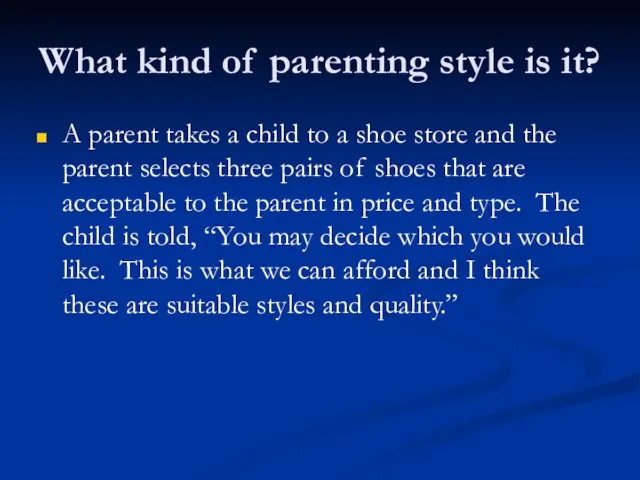
a shoe store and the parent selects three pairs of shoes that are acceptable to the parent in price and type. The child is told, “You may decide which you would like. This is what we can afford and I think these are suitable styles and quality.”
Слайд 14What kind of parenting style is it?
A parent takes a child to
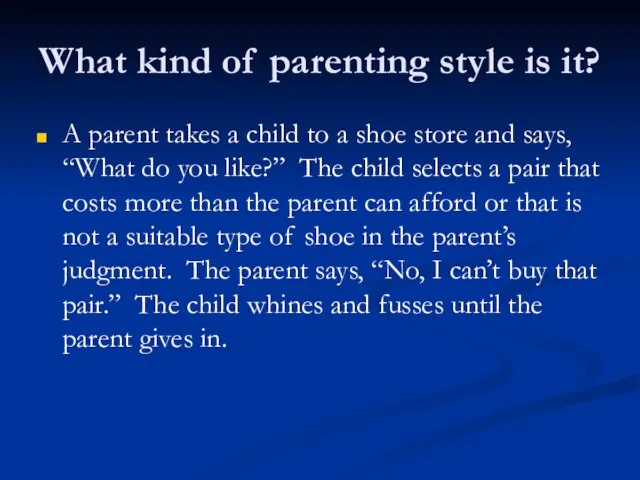
a shoe store and says, “What do you like?” The child selects a pair that costs more than the parent can afford or that is not a suitable type of shoe in the parent’s judgment. The parent says, “No, I can’t buy that pair.” The child whines and fusses until the parent gives in.
Слайд 15What kind of parenting style is it?
A parent takes a child to
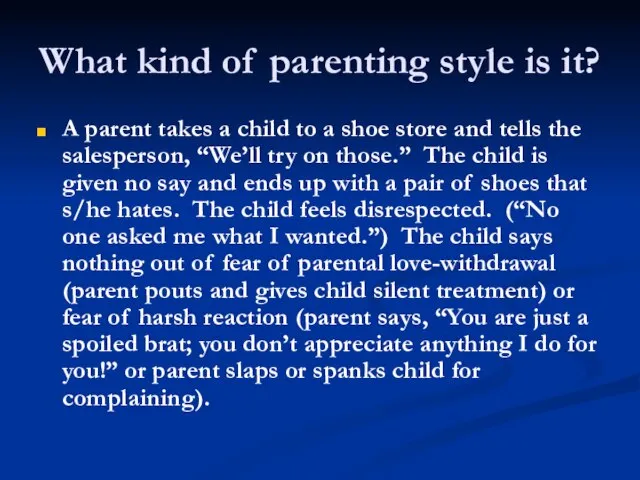
a shoe store and tells the salesperson, “We’ll try on those.” The child is given no say and ends up with a pair of shoes that s/he hates. The child feels disrespected. (“No one asked me what I wanted.”) The child says nothing out of fear of parental love-withdrawal (parent pouts and gives child silent treatment) or fear of harsh reaction (parent says, “You are just a spoiled brat; you don’t appreciate anything I do for you!” or parent slaps or spanks child for complaining).
Слайд 16First born
Mothers became more negative, coercive and played less, when second child
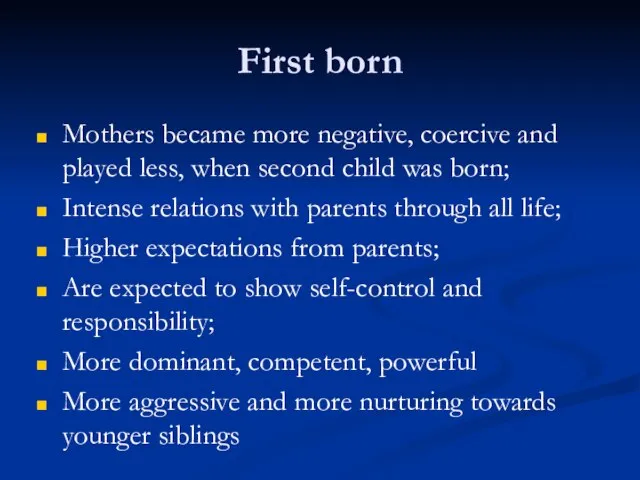
was born;
Intense relations with parents through all life;
Higher expectations from parents;
Are expected to show self-control and responsibility;
More dominant, competent, powerful
More aggressive and more nurturing towards younger siblings
Слайд 17First born
conservative and self-controlled;
jealous and anxious;
typically respectful, conforming, and responsive to authority;
a
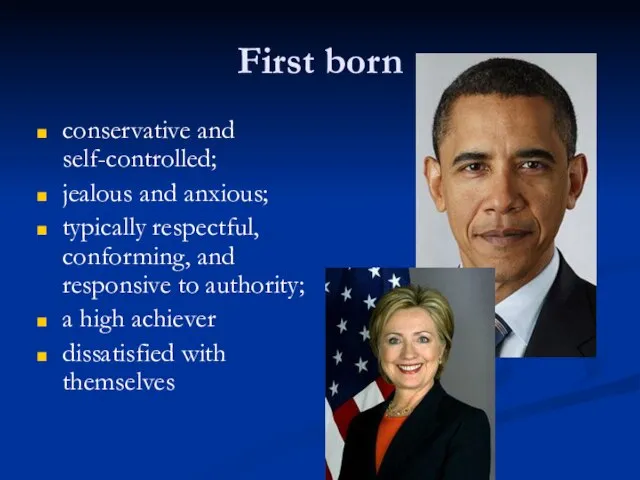
high achiever
dissatisfied with themselves
Слайд 18The Only Child:
typically less anxious, more mature, self-sufficient and optimistic;
Achievement oriented, desirable
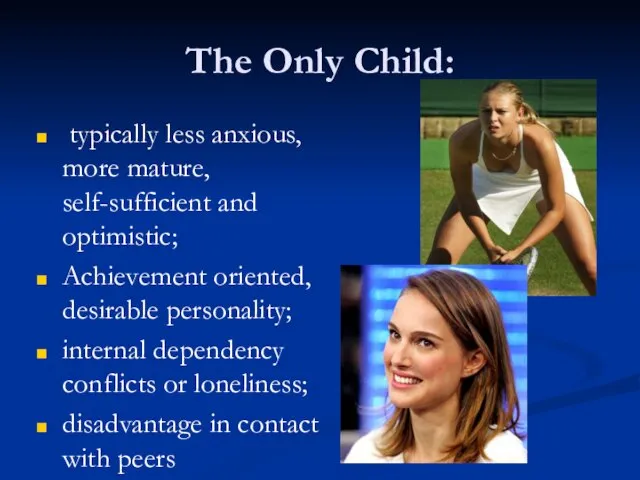
personality;
internal dependency conflicts or loneliness;
disadvantage in contact with peers
Слайд 19The Middle Child:
The most vulnerable to maladjustment;
more excitable, demanding, attention getting, and
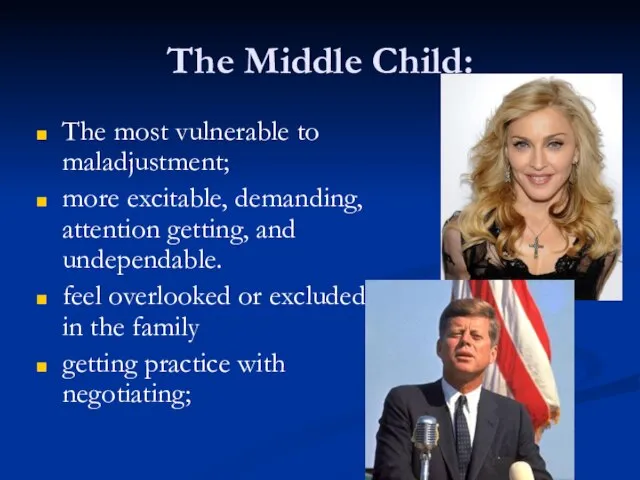
undependable.
feel overlooked or excluded in the family
getting practice with negotiating;
Слайд 20The Youngest Child:
charming, lighthearted, and playful;
being the family pet or suffering from
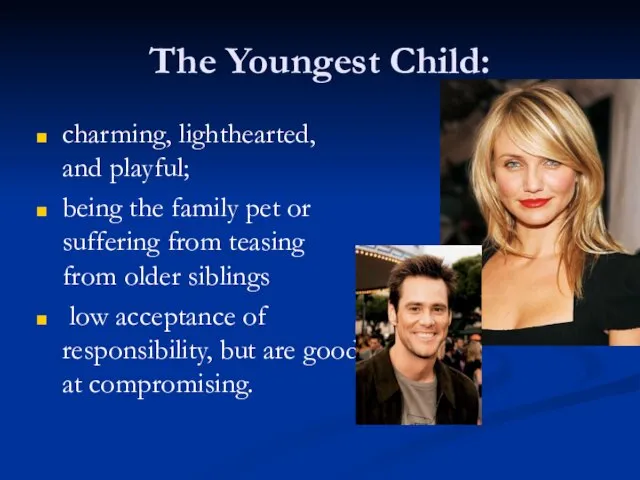
teasing from older siblings
low acceptance of responsibility, but are good at compromising.
Слайд 22Peer statuses
Popular children – happy, concern for others, communication skills, self-confident;
Neglected children
Rejected
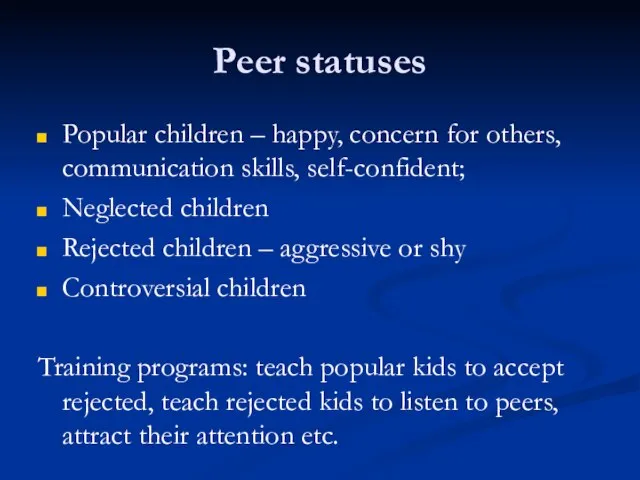
children – aggressive or shy
Controversial children
Training programs: teach popular kids to accept rejected, teach rejected kids to listen to peers, attract their attention etc.
Слайд 23Bullying
Bullies parents – rejecting, authoritarian, permissive on their kid’s aggression;
Victims’ parents –
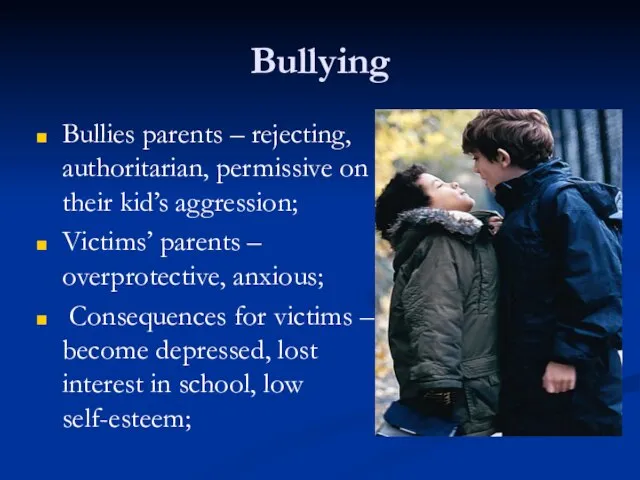
overprotective, anxious;
Consequences for victims – become depressed, lost interest in school, low self-esteem;
Слайд 24Types of play
Unoccupied play
Solitary play
Onlooker play
Parallel play
Associative play
Cooperative play
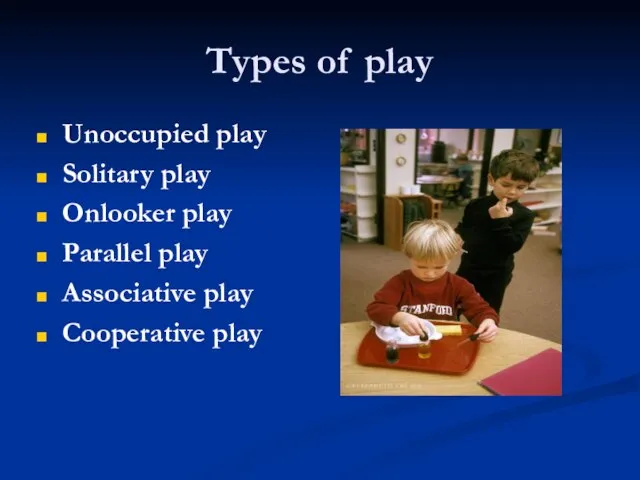
Слайд 26Adolescents’ thinking
adolescent egocentrism - intense preoccupation with one’s own feelings and lack
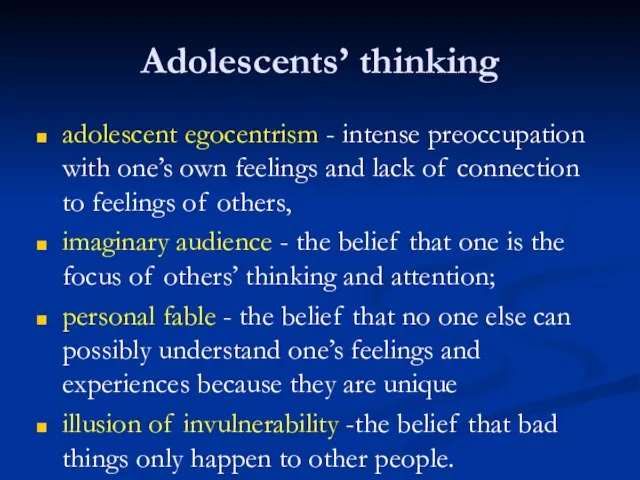
of connection to feelings of others,
imaginary audience - the belief that one is the focus of others’ thinking and attention;
personal fable - the belief that no one else can possibly understand one’s feelings and experiences because they are unique
illusion of invulnerability -the belief that bad things only happen to other people.
Слайд 27Peer pressure
A pressure to think and act like friends;
Conformity peaks in early
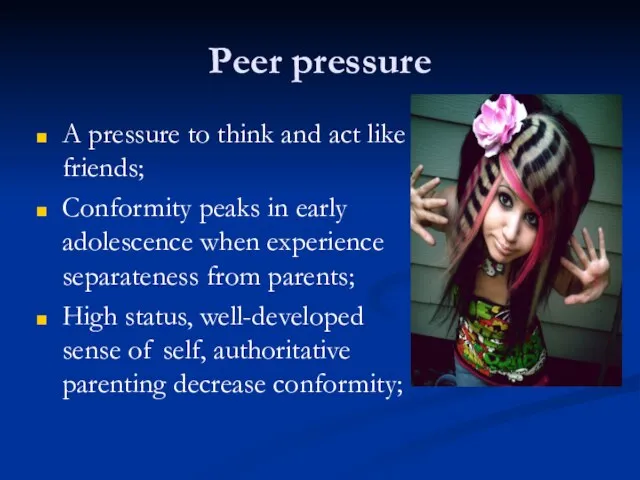
adolescence when experience separateness from parents;
High status, well-developed sense of self, authoritative parenting decrease conformity;
Слайд 28Children of divorce
Why there are so many divorce nowadays? How children react
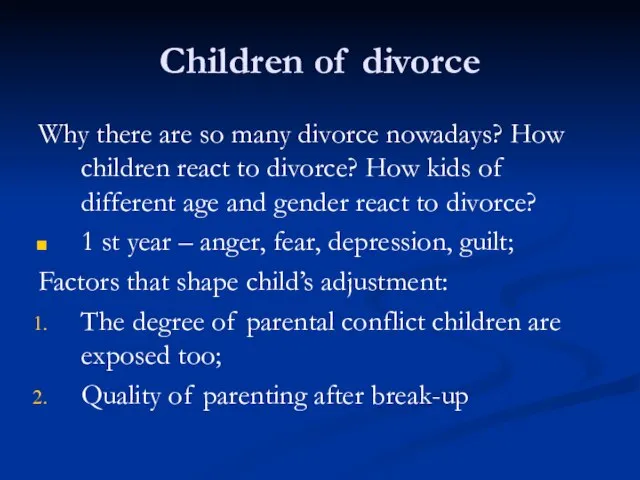
to divorce? How kids of different age and gender react to divorce?
1 st year – anger, fear, depression, guilt;
Factors that shape child’s adjustment:
The degree of parental conflict children are exposed too;
Quality of parenting after break-up
Слайд 29Age differences
Preschoolers – more demanding, sad, regressive behavior, nightmare, bedwetting, boys more
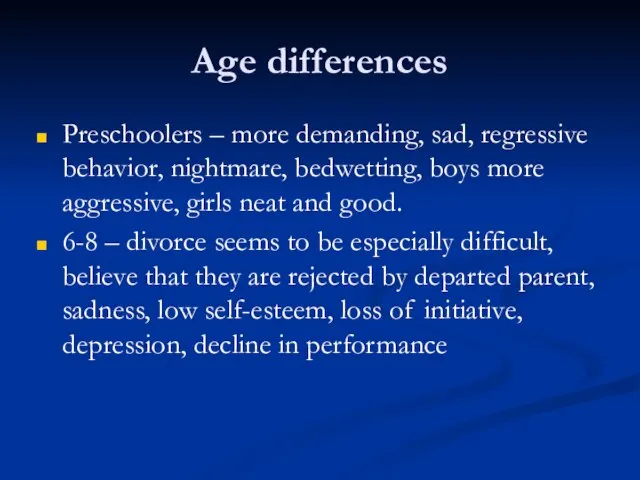
aggressive, girls neat and good.
6-8 – divorce seems to be especially difficult, believe that they are rejected by departed parent, sadness, low self-esteem, loss of initiative, depression, decline in performance



















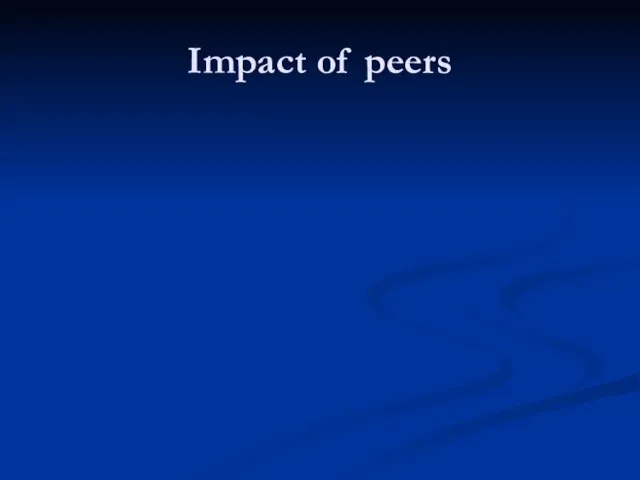



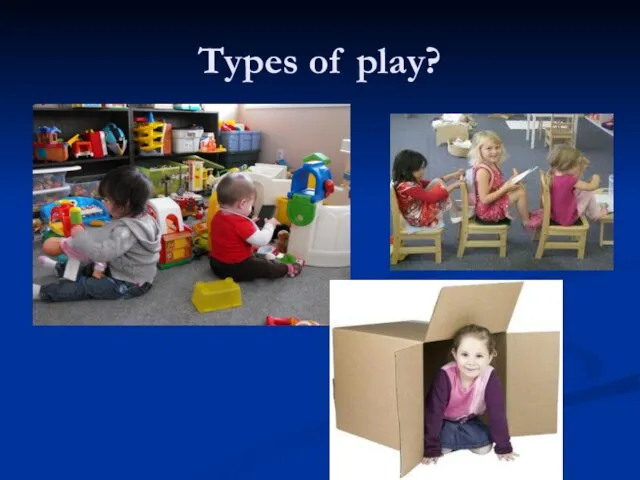




 Воспаление параанальных желез.
Воспаление параанальных желез. Поддержка консультантом суицидального клиента
Поддержка консультантом суицидального клиента Книги о войне воздействуют на нашу память
Книги о войне воздействуют на нашу память Инклюзивное обучение
Инклюзивное обучение Требования к уроку с использованием ИКТ
Требования к уроку с использованием ИКТ Что такое стихи и зачем они нужны?
Что такое стихи и зачем они нужны? Рисование карманов, кокеток, складок различной формы
Рисование карманов, кокеток, складок различной формы Самоцветы России. Разнообразные задания
Самоцветы России. Разнообразные задания Текстовые документы и технологии их создания (7 класс)
Текстовые документы и технологии их создания (7 класс) Профессиональные бизнес решения
Профессиональные бизнес решения №5
№5 Общение как перцепция. Социально-перцептивные характеристики общения. Эмпатия; факторы, влияющие на ее формирование
Общение как перцепция. Социально-перцептивные характеристики общения. Эмпатия; факторы, влияющие на ее формирование Издалека по ночным тропкам
Издалека по ночным тропкам Вильям Прейер и его исследования
Вильям Прейер и его исследования Разнообразие птиц
Разнообразие птиц Современный Санкт-Петербург (фотографии)
Современный Санкт-Петербург (фотографии) Психология чрезвычайных ситуаций. Помощь себе и тем, кто рядом
Психология чрезвычайных ситуаций. Помощь себе и тем, кто рядом Практикум по решению задач. Природа и основные свойства цвета
Практикум по решению задач. Природа и основные свойства цвета Волоконная оптика
Волоконная оптика Алгоритм выхода в туристский поход детской группы образовательной организации
Алгоритм выхода в туристский поход детской группы образовательной организации Развивающие конструкторы Kid K’NEX Education
Развивающие конструкторы Kid K’NEX Education Система основной педагогической документации ДОУ
Система основной педагогической документации ДОУ Орган – король музыкальных инструментов
Орган – король музыкальных инструментов ПИЩЕВЫЕ ДОБАВКИ
ПИЩЕВЫЕ ДОБАВКИ Нравственное воспитание: патриот, гражданин
Нравственное воспитание: патриот, гражданин Химический состав клетки. Неорганические вещества клетки
Химический состав клетки. Неорганические вещества клетки Пользование внешними световыми приборами и звуковыми сигналами (Вопросы (2)
Пользование внешними световыми приборами и звуковыми сигналами (Вопросы (2) Волонтерський рух як одна зі складових діяльності Козирської учнівської республіки Південна
Волонтерський рух як одна зі складових діяльності Козирської учнівської республіки Південна